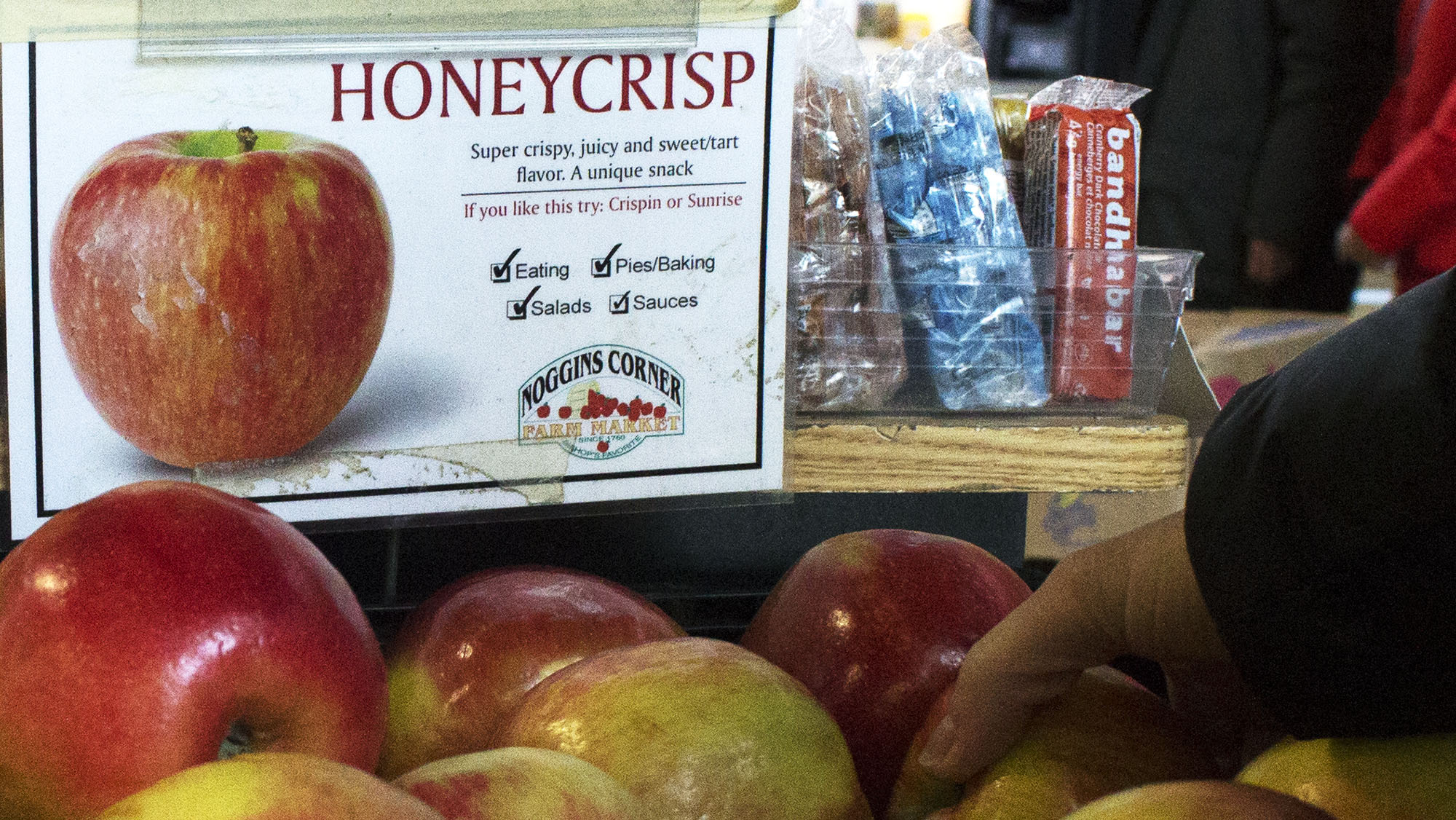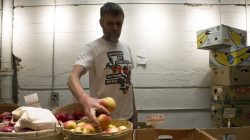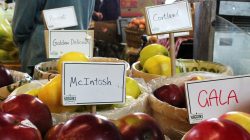FRUIT
The Honeycrisp boom
Honeycrisps surpass McIntosh as Nova Scotia’s most-grown apple, but it's difficult to grow.

caption
A customer shops for apples at the Halifax Seaport Farmers' Market.The Honeycrisp apple is heroic among tree fruit.
“I would say it has pretty much single-handedly carried the apple industry for the past 15 years in Nova Scotia,” says Ted Hutten, a farmer who sells fruit and vegetables at the Halifax Brewery Farmers Market. “I think there has been insatiable — it seemed like almost unlimited — demand for the apple.”
Honeycrisps have become the most-grown, most-exported apple in Nova Scotia, according to the Nova Scotia Fruit Growers’ Association. Apple exports from the province increased by 24 per cent between 2016 and 2017, helped by Honeycrisps. After the apple was developed in the United States, the Nova Scotia government ensured its provincial dominance by helping fund farmers to plant more Honeycrisp trees.
However, Honeycrisps are not for faint-hearted growers. The apple is susceptible to disorders, tedious to harvest and temperamental when storage temperatures change. Nova Scotia’s climate creates apples with international demand, but decades of research have gone into creating the Honeycrisp heyday. Related stories
“People look at apples, and they say, ‘well, isn’t that cute?’” says John DeLong, a researcher at the Kentville Research and Development Centre, which is run by the federal government. “But the science involved, even at the grower level — the amount of knowledge these guys have to have to do this successfully — really is amazing.”

caption
Ted Hutten sells apples at the Halifax Brewery Farmers Market.Finicky fruit
DeLong has studied apples for 23 years. Since Honeycrisps in a single orchard do not all mature at the same time, he says, farmers often need to harvest an orchard three times per season. Even after being harvested, problems can arise.
“Soggy breakdown” is a disorder that creates rings of soggy brown tissue, sometimes around the entire apple, DeLong says. To prevent it, farmers must store the apples in room temperature for one week before cooling them.
Since Honeycrisps have thin skin, they can be easily punctured by the stems of other Honeycrisps. To avoid the punctures, farmers must take a tool — “a glorified pair of scissors,” as DeLong describes it — and snip off every stem.
Despite the difficulties, DeLong says the Honeycrisp does not risk being replaced by a better variety. He says they can fetch three times the price as traditional varieties, costing approximately $600 per bin.
“I think Honeycrisp is here to stay,” DeLong says. “There are lots and lots of people out in apple land that like it.”

caption
Honeycrisps compete with other apple varieties grown in Nova Scotia.Branching out
Drew Martin is a customer at the farmers’ market on Barrington Street. As a father of five children, he drives from Dartmouth every second week and buys 50 pounds of apples. He chooses Jonah Golds rather than Honeycrisps.
“They’re overrated,” Martin says of Honeycrisps. “Jonah Golds have tartness and sweetness and flavour and texture.”
Martin buys the apples from Ted Hutten, who agrees Honeycrisps are overrated.
“Ninety per cent of my customers feel that way,” Hutten says. “I feel that the apple is, I wouldn’t say ‘on its way out,’ … (but) I think as a North American industry, I now feel that the market is somewhat saturated.”
The province’s Honeycrisp supply grew substantially between 2005 and 2010, when the Nova Scotia Department of Agriculture invested nearly $1.2 million in the Honeycrisp Orchard Renewal Program. By 2009, farmers had planted 129,000 more Honeycrisp trees.
“Definitely Honeycrisp has taken the lead,” says Candy O’Connor, director of the Nova Scotia Fruit Growers’ Association. She says McIntosh is now the second most-grown apple in the province, and Honeycrisps are popular outside the province because they are so red.
“It sounds silly, but our warm days and cool nights help establish the colour,” she says.
In 2014, the province invested another $2.2 million in a six-year program to give incentives to apple farmers. Instead of solely focusing on Honeycrisps, it enabled farmers to use the money to plant other new varieties.
“The Honeycrisp is finicky to store, in how it likes to be harvested,” says Carolyn Cameron, whose father, Andrew Bishop, owns Noggins Corner Farm in the Annapolis Valley. After the first Honeycrisp funding program, Cameron says, “I think a lot of growers were pushing back on that, saying, ‘We want to grow Ambrosias or Galas. Let’s not just put ourselves in a box.’”
SweeTango and Pazazz are two varieties competing to achieve Honeycrisp-level demand, and the research station in Kentville has developed its own varieties, including one called Cotton Candy.
But the next Honeycrisp might not be an apple at all. Cameron says, “For us, I would say the next Honeycrisp is the Cold Snap pear.“
